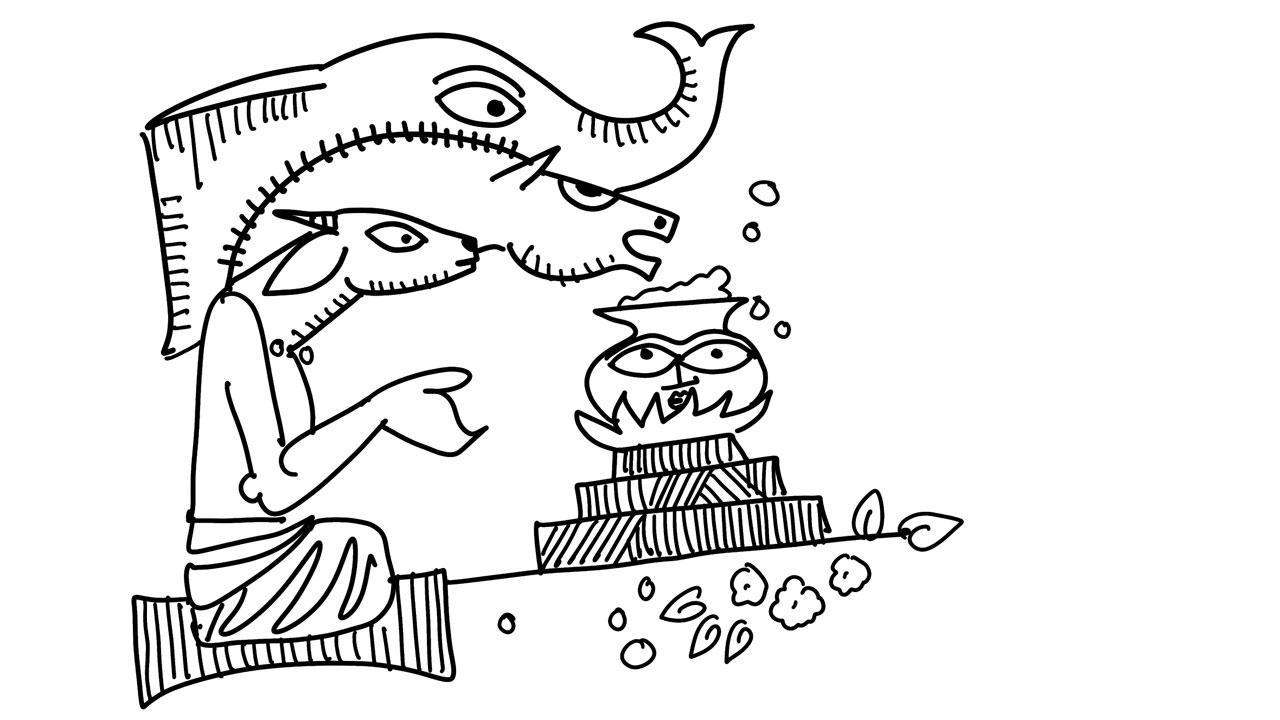This leads many people to speculate that ancient Indians knew the art of head transplantation

Illustration/Devdutt Pattanaik
 We have heard stories of how Shiva beheaded his father-in-law Daksha Prajapati and replaced Daksha’s head with that of a goat and how he beheaded his son Ganesha and replaced Ganesha’s head with that of an elephant. We have also heard folk stories of how devotees offer their head as a sacrifice to the goddess Durga, who then, replaces the head and then blesses the devotee. These stories come from the Puranic tradition and are about 1,500 years old.
We have heard stories of how Shiva beheaded his father-in-law Daksha Prajapati and replaced Daksha’s head with that of a goat and how he beheaded his son Ganesha and replaced Ganesha’s head with that of an elephant. We have also heard folk stories of how devotees offer their head as a sacrifice to the goddess Durga, who then, replaces the head and then blesses the devotee. These stories come from the Puranic tradition and are about 1,500 years old.
However, a thousand years before that, in the Vedic tradition, we find similar stories. Rishi Dadichi’s human head was replaced with a horse’s head by the Ashwini Kumars so that he could reveal secrets of rejuvenation Indra would not share. When Dadichi revealed the secret the horse’s head burst into a thousand pieces. Then the Ashwini Kumars placed back his human head. Ashwins had learnt this secret from Chyavana Rishi. Chayavana was an ancient sage associated with Ayurvedic surgery. This leads many people to speculate that ancient Indians knew the art of head transplantation.
An even older story tells us how Vishnu lost his head and the Ashwins replaced it. The Brahmana texts, which provide explanations for various Vedic rituals, inform us that Vishnu, with his bow and arrow, was extremely powerful and could protect all the gods. The gods wanted this power and did not know how to get it as it was located in Vishnu’s head. So once, when Vishnu was resting his chin on his bow, the gods asked an ant to eat the thread of the bow. The ant did so, the thread broke, the staff of the bow snapped up and Vishnu’s head was cut. It flew into the sky, and became the Sun which is why Vishnu is called Surya Narayana. Vishnu’s body fell to the ground with his neck pointing towards the eastern direction.
Also read: The art of no resolutions
In later Puranic stories, the Ashwins replaced Vishnu’s lost head with a horse’s head. The horse-headed Vishnu then could kill a horse-headed demon called Hayagriva and recover the Vedas. The horse-headed form of Vishnu known as Hayagriva is especially popular in South Indian culture and connected with knowledge. In Yajur Veda, the horse-headed sun is said to have taught Vedic secrets to Yagnavalkya. Thus the head, the horse, and the sun are connected with secret knowledge.
This inspired the Pravargya ritual, a secret ritual performed outside the village, where special pots called Mahavira, representing the solar head of Vishnu are placed on fire. In this pot, the milk of a cow and goat, along with ghee was boiled and offered to the Ashwins.
These stories are stories of loss and renewal. Pots contain food. Bad quality pots cause loss of food that is then consumed by ants. Bad quality heads lead to leakage and loss of secret knowledge.
They also speak of wilful death and wilful rebirth—the rebirth of Vishnu, Dadhichi, Daksha and Ganesha. A man who dies in sin, and is reborn in faith becomes “born-again” as Christians would say. Or a man born of a woman who is reborn through his guru becomes ‘dvija’ or twice-born as Brahmins would say.
The author writes and lectures on the relevance of mythology in modern times. Reach him at devdutt.pattanaik@mid-day.com
 Subscribe today by clicking the link and stay updated with the latest news!" Click here!
Subscribe today by clicking the link and stay updated with the latest news!" Click here!










